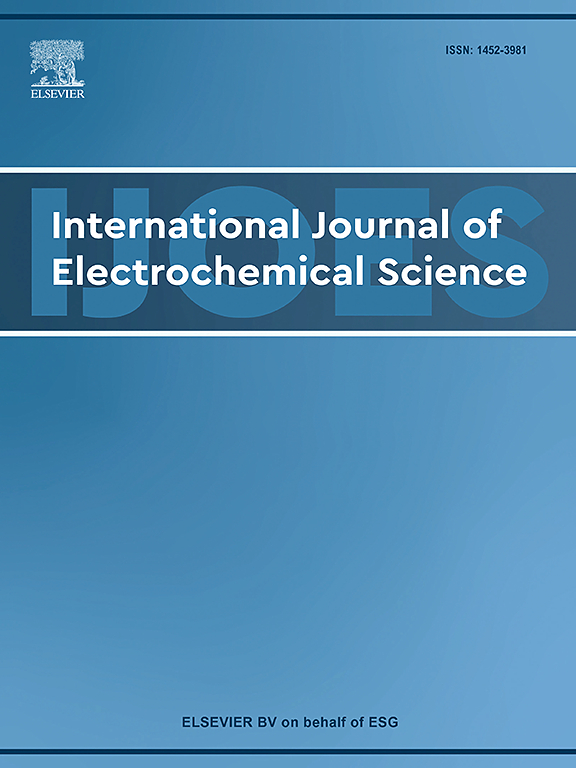Comparative analysis of electrochemical properties and thermal behaviors of sodium ion and lithium ion batteries
IF 1.3
4区 化学
Q4 ELECTROCHEMISTRY
International Journal of Electrochemical Science
Pub Date : 2025-04-11
DOI:10.1016/j.ijoes.2025.101027
引用次数: 0
Abstract
Sodium-ion batteries (SIBs), characterized by their abundant raw material sources and cost-effective manufacturing processes, have emerged as one of the most promising battery technologies. However, the existing literature on the electrochemical and thermal generation characteristics of SIBs remains limited. This dissertation conducts a comparative investigation of the electrical-thermal properties of 18650-type SIBs and Lithium-ion batteries (LIBs) from both macroscopic and microscopic perspectives. The initial phase of the study involved conducting experiments under standard operating conditions, with variations in ambient temperatures and discharge rates. Furthermore, investigations into overcharging and thermal runaway (TR) were conducted under extreme conditions, with concurrent studies on heat generation and electrochemical analyses. The underlying mechanisms responsible for macroscopic performance variations were elucidated through microstructural characterization.
The experimental findings reveal that at an ambient temperature of 0 °C, the State of Charge (SOC) of Sodium-Ion Batteries (SIBs) exceeds that of Lithium-Ion Batteries (LIBs) by 13.93 %. Under standard operating conditions, LIBs demonstrate enhanced cyclic capacity retention relative to SIBs, albeit with higher thermal generation. Under abusive conditions, the performance of SIBs markedly deteriorates, accompanied by a substantial increase in heat generation, surpassing that of LIBs. Following abuse, SIBs experience thermal runaway, attaining a peak temperature of 273.9 °C. The performance degradation is primarily attributed to severe sodium deposition on the anode and the subsequent detachment of active materials. These findings furnish essential experimental data and theoretical underpinnings for the industrial deployment of SIBs, while providing critical insights for optimizing their production processes and improving thermal safety performance.
钠离子电池和锂离子电池电化学性能和热性能的比较分析
钠离子电池(SIBs)以其丰富的原料来源和低成本的制造工艺而成为最有前途的电池技术之一。然而,关于SIBs的电化学和热生成特性的现有文献仍然有限。本文从宏观和微观两个角度对18650型SIBs和锂离子电池的电-热性能进行了比较研究。研究的初始阶段包括在标准操作条件下进行实验,环境温度和放电速率会发生变化。此外,还对极端条件下的过充和热失控(TR)进行了研究,同时进行了产热和电化学分析的研究。通过微观结构表征阐明了宏观性能变化的潜在机制。实验结果表明,在0 °C的环境温度下,钠离子电池(SIBs)的荷电状态(SOC)比锂离子电池(LIBs)高出13.93 %。在标准操作条件下,lib比sib表现出更强的循环容量保持能力,尽管产生的热量更高。在滥用条件下,sib的性能明显恶化,并伴随发热量的大幅增加,超过lib。滥用后,sib经历热失控,达到273.9 °C的峰值温度。性能下降主要是由于阳极上严重的钠沉积和随后的活性物质脱落。这些发现为sib的工业部署提供了必要的实验数据和理论基础,同时为优化其生产工艺和提高热安全性能提供了关键见解。
本文章由计算机程序翻译,如有差异,请以英文原文为准。
求助全文
约1分钟内获得全文
求助全文
来源期刊
CiteScore
3.00
自引率
20.00%
发文量
714
审稿时长
2.6 months
期刊介绍:
International Journal of Electrochemical Science is a peer-reviewed, open access journal that publishes original research articles, short communications as well as review articles in all areas of electrochemistry: Scope - Theoretical and Computational Electrochemistry - Processes on Electrodes - Electroanalytical Chemistry and Sensor Science - Corrosion - Electrochemical Energy Conversion and Storage - Electrochemical Engineering - Coatings - Electrochemical Synthesis - Bioelectrochemistry - Molecular Electrochemistry

 求助内容:
求助内容: 应助结果提醒方式:
应助结果提醒方式:


